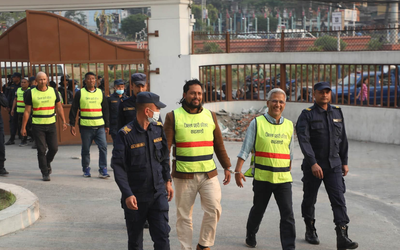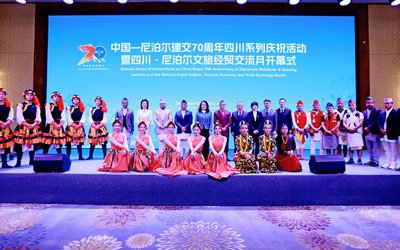More on News





The understanding of child labour in Nepal is as diverse and complex as in the other parts of the globe. The National legislation defines child as a person below the age 16 years. There are different opinions from various quarters and sectors regarding “What child labour is and what is not child labour?” But above all the definitions the most crucial thing to remember is “What work is appropriate for children?" and “What kind of work should be categorized as inappropriate for children?”
The ILO defines child labour as the work that deprives children of their childhood, education, their potential and their dignity, and work that is harmful to their physical and mental development. While governments have raised commitments to find new solutions to end exploitative work for children, the priority remains with the worst forms of child labour such as slavery, trafficking of children, debt bondage, forced or compulsory labour, use of children in armed conflict, prostitution, pornographic performances or illicit activities, and in particular, in the production and trafficking of drugs. The Member States in the recent years have come under increased pressure also to eliminate the hazardous child labour, the work that jeopardises the physical, mental or moral well being of a child, either because of its nature or because of the conditions in which it is carried out.
Child labour has been widespread in Nepal for many centuries, mostly in rural areas, as it is considered to be a part of the normal process of socialization. Children in the earlier days, and even today, have worked for as long as families have needed their support in the farms and in the fields. Doing this deprives them of their education, right to grow in a conducive environment, and have fun (especially because enjoying childhood is considered equally crucial for children's growth and mental and often physical development).
With the passage of time, along with the emergence of modernisation and globalisation, child labour remains to be equally concerned especially among the urban cities, where it is less in formal but massive in the informal sectors. This has changed the overall perception of child labour in Nepal from rural to urban, from agriculture bonded child labour to children involved in labour work in hotels, industries, urban transportation, brick kilns, jari (embroidered fabrics), in legal and illegal occupations from night clubs, dance bars, restaurants to pornography and child prostitution. Now this brings us to the question: What kind of child labour are we talking about?
The international community has set a target of eliminating the worst forms of child labour by 2016. A Global Conference on Child Labour held in Hague in 2010 established a Roadmap for action to eliminate the Worst Forms of Child Labour by 2016 and the progress towards the goal will be reviewed at a Global Conference to be held in Brazil in 2013. With this in mind it is timely for all the actors involved in the international and national level to reflect upon the actions and pave ways of tackling the worst forms of child labour in Nepal.
According to the Nepal Child Labour Report 2010 (based on the National Labour Force Survey 2008), launched recently on the occasion of the World Day Against Child Labour on 12 June 2012, there is a decline in the 5-14 year-old children engaged in economic activities in Nepal—from two million (48%) in 1998 to nearly 1.5 million (41%) in 2008. The decrease of child labour in sectors related to carpet making, beedi making, stone quarries, bonded child labour, portering has provided a positive message that the end of child labour is in sight! Concrete efforts are being made by the Government of Nepal, trade unions, employers’ organisations, and the civil society to address child labour issues, and the progress achieved in this area in recent years is simply undeniable.
The Government of Nepal has clearly demonstrated its commitment to the elimination of child labour. The ratification of two ILO core Conventions on Child Labour No. 138 on the Minimum Age for Employment and No. 182 on the Worst Forms of Child Labour was followed by the establishment of a number of legislative and legal frameworks including the National Master Plan on the Elimination of Child Labour (2004-2014). From 1990 onwards and in line with the spirit of the two core Conventions, the Government is in pursuit of strategies and plans effective for child labour abolition. It is with this view that the 2004-2014 Plan was further improved and updated in 2010 with the elaboration of a revamped National Master Plan (NMP, 2011-2020) on Child Labour which is awaiting the Government’s endorsement. The NMP aims at re-energizing Government actions towards the target of elimination of all worst forms of child labour by 2016 and all child labour by 2020.
The current NMP addresses a “parallel track” approach: prevent children from child labour and rehabilitate children (and their families) caught in child labour. The current NMP recognizes that poverty, among others, is the contributing factor to child labour, and that many children from the poor families are sent to work to generate income. It highlights the various deficiencies (relating to policy, legislation and enforcement, knowledge, education, child protection, institutional and implementing capacity, and awareness) that are impeding on efforts to eliminate child labour and its worst forms in particular.
The same NMP crystallizes that child labour must be addressed through multi-sectoral preventive and rehabilitation work and Ministerial coordination. Addressing poverty and the deficiencies in education and social protection policies are crucial for the abolishment of child labour. The NMP stipulates that technical and financial income generating activities, and improved decent employment generating (vocational) education are needed for the families to bridge the gap between poverty and child labour for survival.
Another concrete and fundamental step was the creation of the Child Labour Elimination Section (CLES) under the Ministry of Labour and Employment. Today, the CLES is the key national entity for coordinating, monitoring, and reporting on child labour interventions in the country. The CLES is the main counterpart agency of the ILO technical cooperation programme to support the implementation of the Nepal National Master Plan on the prevention and elimination of Child Labour.
The CLES, the Ministry of Labour and Employment and the ILO are also working directly with workers’ and employers’ organisations (social partners) on a number of programmes within the framework of the National Master Plan. This tripartite partnership entails consultations over the development of the National Child Labour Policy, amendments to national legislative and regulatory framework, the determination of hazardous child labour, strengthening the capacity of relevant stakeholders, and advocacy and awareness activities for child labour elimination. The social partners in Nepal have undertaken important initiatives on child labour prevention, but for greater impact, these efforts need to be taken to scale, and for sustainability, they need to be integrated in their policies, plans, and budgets.
More recently, the Ministry of Local Development and the Ministry of Women, Children and Social Welfare have also committed to join efforts with the Ministry of Labour and Employment aiming at joint action to reach out to a wider target base through decentralised agencies of the Government of Nepal, including District Development Committees, Village Development Committees and Municipalities. However, despite the Government’s commitment and its efforts supported by the social partners and civil society, challenges remain and these impede efforts to ensure the rights for the youngest citizens of the nation and to achieve the national goal to end child labour.
A key challenge relates to the developing status of the institutional and human resource capacity, to coordination, monitoring, and reporting on child labour elimination efforts. The capacity issue is affected by, and in turn exacerbates by, a knowledge base that is not sufficiently updated and utilized to facilitate child labour policy development and the promotion of mainstreaming child labour issues and concerns in relevant development programmes and budgets. These challenges have underlined ILO support to the Ministry of Labour and Employment and the CLES, particularly in the development and implementation of the National Master Plan (2011-2020).
Nepal is one of the few countries in South Asia that has not developed a policy on child labour, nor a workable determination of hazardous child labour. Presently, this is one of the top priorities of the Government together with the social partners and civil society to extend the scope of their programs. Ending child labour needs actions on many levels: development and enforcement of legislation, better education, integrated and comprehensive approaches, including market measures to promote accelerated economic development and employment creation, effective social protection measures, vocational training, improved labour inspection awareness at an individual and community level, thus creating a society with “zero tolerance” to child labour and benefiting from a reality that Nepal is free from child labour.
Assalino is Director ILO Country Office for Nepal







